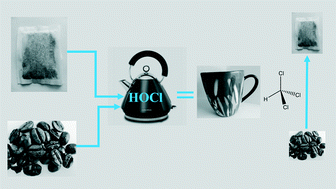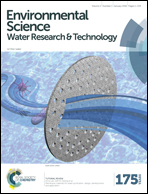Emerging investigators series: formation of disinfection byproducts during the preparation of tea and coffee†
Abstract
This study examined the formation of selected disinfection byproducts (DBPs) during the chlorination of breakfast, Earl Grey and green tea, and from instant and filter coffee. Eight model compounds representing the organics in tea and coffee were also tested. Initially, experiments using water pre-spiked with chlorine demonstrated chlorine concentrations of 1–19 mg L−1 were reduced by 5–19% through boiling in a kettle. The chloroform (trichloromethane) yield of 47.6 ± 0.3% from chlorination of catechin hydrate is high compared with surrogates of drinking water natural organic matter (NOM). Chloroform yields from tea chlorinated under formation potential conditions were similar to reactive drinking water NOM isolates and higher than from coffee. Chloroform generated during the preparation of tea reached 30–43 μg L−1 at the highest chlorine dose of 14.2 mg L−1. Under the same conditions no chloroform was detected in instant coffee, whereas up to 3 μg L−1 chloroform was generated from filter coffee. Overall, this study demonstrates the potential for DBP formation when tea is prepared in water containing elevated chlorine concentrations, such as following point-of-use treatment. Conversely, chloroform concentrations in tea prepared with water containing 1 mg L−1 chlorine were ≤4 μg L−1 and therefore trichloromethane (THM) concentrations in tea made using municipal tap water are likely to be insignificant.

- This article is part of the themed collection: Emerging Investigator Series


 Please wait while we load your content...
Please wait while we load your content...